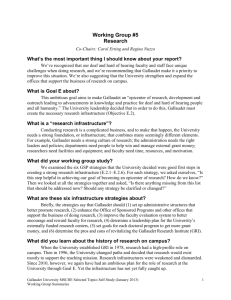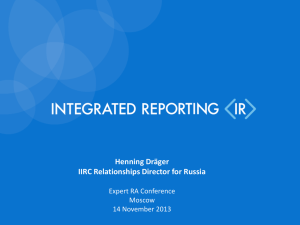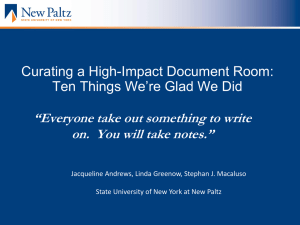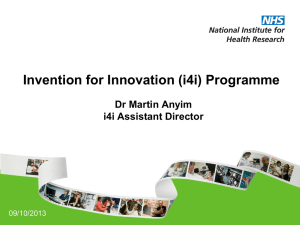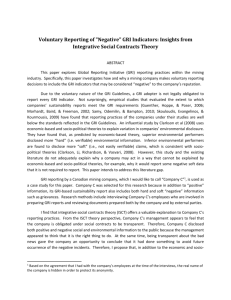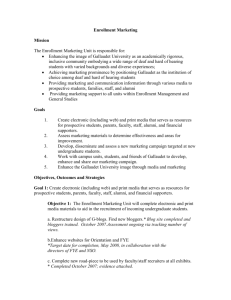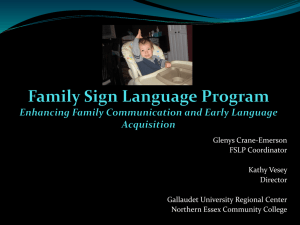chapter 6: strategic planning for research
advertisement
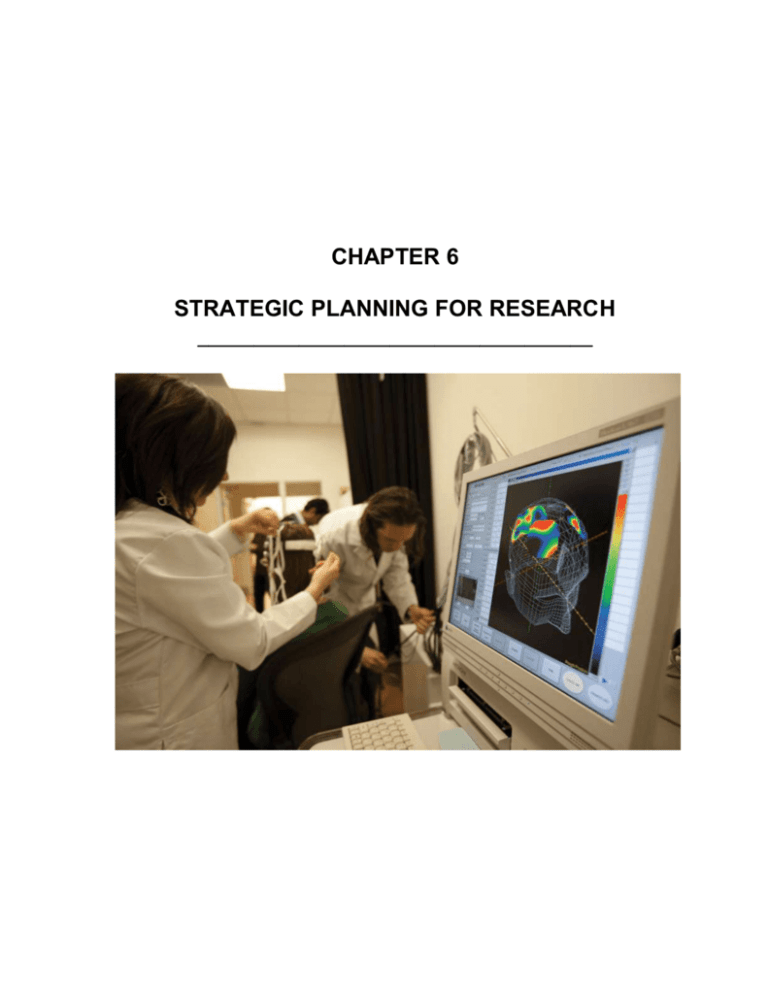
CHAPTER 6 STRATEGIC PLANNING FOR RESEARCH ___________________________________ CHAPTER 6: STRATEGIC PLANNING FOR RESEARCH Overview This section reports on our work to analyze aspects of the University’s goal to “establish Gallaudet as the epicenter of research, development, and outreach leading to advancements in knowledge and practice for deaf and hard of hearing people and all humanity,” popularly referred to as the “research goal,” or “Goal E.” It is important to note that Goal E was effectively placed “on hold” in fiscal year (FY) 2010 and FY 2011 to allow the University to focus first on enrollment (Goal A) and retention (Goal B). Goal E was the sole goal in the Gallaudet Strategic Plan (GSP) that was not prioritized and implemented immediately. In 2011, at the same time that this working group and Self-Study began, the University president indicated that Goal E would be a priority in FY 2012. Because progress toward achievement of Goal E would be difficult to analyze in the absence of official prioritization and allocation of resources, and because key elements of the infrastructure (the focus of Objective E.2) have not yet been put into place, the working group for this portion of the Self-Study decided to take advantage of the opportunity to use strategic planning practices to re-examine crucial elements of Goal E. This approach is especially useful, given the timeline for the development of the original GSP was ambitious with the entire process taking only five months (January to May 2009). Because we deemed Objective E.2, which focuses on “creat[ing] the infrastructure needed to support a world-class research enterprise,” as fundamental to Goal E’s success, we chose this area for the focus of the Self-Study. Infrastructure in this context refers to the campus systems and resources that support research activities, such as leadership structures, administrative policies, administrative procedures, physical and virtual facilities, fiscal resources, human capital, and, perhaps most crucially, a campus culture that embraces academic research. Achieving the other two objectives, setting external funding targets (E.1) and enhancing outreach (E.3), are unlikely to succeed without a strong research infrastructure in place. The members of the Self-Study working group that examined Goal E were chosen to maximize the participation of crucial research constituents on campus. Members included the directors of the University’s three externally funded research centers, the director of the Office of Sponsored Programs (OSP), the director of one of the five doctoral programs, the director of the University’s first biological research laboratory, and a bioethics researcher. The group was cochaired by the dean of the Graduate School and Professional Programs (GSPP) and by an undergraduate associate professor in a STEM (science, technology, engineering, and mathematics) field. In an attempt to benchmark infrastructure strategies, the GSPP dean commissioned a custom research report to identify peer institutions for Gallaudet with respect to our special population of students and our ambitious research goal. In addition, to allow for participation by the larger campus community, the group developed a “research climate” survey to better understand the research infrastructure needs and concerns of University faculty and staff. The survey also provided a great deal of quantitative and qualitative data on the research culture on campus, which the dean plans to share with the campus community in a separate report. The group’s self-study questions generally fall under one (or both) of the following analytic questions: Gallaudet University MSCHE Selected Topics Self-Study (2013) Chapter 6: Strategic Planning for Research 3 1. To what extent are the six GSP strategies supporting Goal E, Objective 2 (infrastructure) appropriate to achieve the strategic plan goal of “establishing Gallaudet as the epicenter of research, development and outreach leading to advancements in knowledge and practice for deaf and hard of hearing people and all humanity”? 2. To what extent are the six GSP strategies supporting Goal E, Objective 2 (infrastructure) sufficient to achieve the strategic plan Objective to “create the infrastructure needed to support a world-class research enterprise?” Background Since establishing the Gallaudet Research Institute (GRI) in 1978, the University has moved from having an ambitious and prominent role for research (1978–1995), to a greatly diminished role in which research primarily supported the teaching mission (1996–2009), then back to the ambitious strategic goal we now have “to be the epicenter of research, development, and outreach” (2010–present). During that time, changes in the research infrastructure reflected the changing prominence of research. Recognizing the degradation of the infrastructure, especially one that could support large-scale research efforts with ambitious outcomes, led the University community to develop Objective E.2, “[to] create the infrastructure needed to support a world-class research enterprise.” What follows is a condensed history of the changes that occurred from 1978 to 2009, as outlined in strategic planning and administrative restructuring documents. From 1978 to 1987, the leadership structure at Gallaudet included a Division of Research led by the vice president for research, who reported to the president; a dean of GRI; OSP; and seven research centers, each administered by a director (Division of Research retreat documents, November 6-7, 1979). In 1982, the administrative structure of the University changed: the Division of Research was eliminated; leadership for research was assigned to the graduate dean (who reported to the provost); and GRI was led by an associate dean (Letter from President Jerry Lee to the campus community). By 1988, GRI had grown to include the following seven centers: Assessment and Demographic Studies; Education and Human Development; Auditory and Speech Sciences; Culture and Communication Studies; Mental Health; Technology Assessment; and Genetic Services. Altogether, GRI employed more than 80 research faculty and staff (GRI retreat documents). Eight years later, as a result of a review and restructuring of Academic Affairs and with the stated intent of integrating research with teaching to support academic programs, all discrete GRI centers were closed. Faculty assigned to GRI (85% time for research, one course per year teaching) were integrated into academic departments and became regular faculty with increased teaching loads. GRI, which was downsized to approximately 25 staff, was led by a director who reported to the dean of Graduate Studies and Research, who in turn reported to the vice president for Academic Affairs (Reconceptualization of Research at Gallaudet University). In 2000, the University developed a new strategic plan, termed Action-ResultsAssessment-Planning, and included research in strategic goal 2, objective 1: “Research supports student achievement and program excellence, and contributes to quality state-of-the-art educational services for deaf and hard of hearing people.” By 2002, a subsequent restructuring of Academic Affairs eliminated the dean of Graduate Studies and Research, replacing it with a dean of GSPP and two associate deans, one responsible for professional programs (academic departments) and the other for research and outreach (Gallaudet University Organizational Chart). The latter never Gallaudet University MSCHE Selected Topics Self-Study (2013) Chapter 6: Strategic Planning for Research 4 materialized. Instead, the second associate dean became the associate dean for Graduate Education and Extended Learning, and the GRI director and OSP reported directly to the GSPP dean. In 2003, as part of a new Academic Affairs planning process, a white paper was written on the state of research at Gallaudet, which concluded, after assessing the results of the reconceptualization and reorganization of research in 1996, that Gallaudet had experienced a marked decrease in research productivity since 1996. Since 1996, GRI has steadily decreased in size to its present position count of three research scientists and six support staff, a 64% drop in staffing since the downsizing of GRI from 80 to 25 employees in 1996, and an 89% drop in staffing since 1988 when staffing was at its peak. In fact, from 1996 through 2009 (when Goal E was established), all externally funded research grants were headed by only 14 faculty (about 7% of the total number of faculty) and 9 staff. Two of these 14 faculty members were members of GRI and assigned 85% of their time to research, and five others were former members of GRI. Of the three faculty members who were undergraduate faculty, all had previously been members of GRI. Of the nine staff members who were principal investigators (PIs) during these 13 years, seven continued to be members of GRI. In 2006, the National Science Foundation (NSF) began funding the Science of Learning Center on Visual Language and Visual Learning (VL2) at $2,000,000 for the first two years and $4,000,000 for the following two years, with the GSPP dean, who also formerly worked in GRI, as PI (VL2 Report to the Program Prioritization Task Force, PPTF). In addition, two National Institute on Disability and Rehabilitation Research centers continued to receive funding during this time: the Rehabilitation Engineering Research Center on Telecommunications Access (RERC-TA), with $300,000 to $400,000 per year and the Rehabilitation Engineering Research Center on Hearing Enhancement (RERC-HE), with nearly $1,000,000 per year. These centers were housed in the departments of Communication Studies, and Hearing, Speech, and Language Sciences, respectively. When the GSP was developed in 2009, the consultants and campus participants on the planning committee recognized the potential that existed for an expanded role for research, development, and outreach through partnerships and external funding as well as the need for an enhanced infrastructure to support objectives E.1 and E.3 (VL2 Report to PPTF; RERC-TA Report to PPTF; RERC-HE Report to PPTF; GRI Report to PPTF; PowerPoint presentation from Booz Allen Hamilton). Gallaudet University MSCHE Selected Topics Self-Study (2013) Chapter 6: Strategic Planning for Research 5 Analysis and Discussion The analysis below first explores to what extent each of the six infrastructure strategies is appropriate for the objective of creating a strong research infrastructure to support the goal of becoming an “epicenter of research.” Our criteria for determining the appropriateness of each strategy are based on components of good planning processes. For example, was this strategy developed in response to an objectively documented need? Has external evidence subsequently supported the need for this strategy? Is the strategy clearly stated? Is it suitable for being used for planning and the allocation of resources? Additionally, we considered the necessity of the strategy. Is the strategy directly linked to its objective and goal? Is it useful? What would happen if this strategy were removed? If the strategy’s absence makes it difficult or impossible to achieve the objective and goal, then the strategy is necessary. Our analysis then proceeds to consider the six strategies as a whole to determine whether they are sufficient and what gaps may exist in the current strategic framework. That is, does current evidence or analysis suggest we need additional strategies to establish a strong research infrastructure? Does evidence suggest that we should reframe any current strategies? The six strategies for Goal E, Objective 2 are: E.2.1 Assess and provide the necessary administrative leadership to promote research synergies within and outside the University. E.2.2 Evaluate and provide appropriate staffing complement and resources to enhance services of OSP and post-award support, including professional development and training in grant writing and management for faculty and support staff. E.2.3 Align faculty evaluation and incentive systems to encourage and reward grant-funded research and peer-reviewed publication. E.2.4 Build administrative infrastructure and leadership succession needed to support and institutionalize externally funded research centers such as VL2, RERC-TA, and RERC-HE. E.2.5 Set expectations for all doctoral programs to apply for external funds for research, with significant support for graduate students. E.2.6 Determine strategic cost/benefit of revitalizing GRI (including re-creating center for assessment and demographic studies). E.2.1 Assess and provide the necessary administrative leadership to promote research synergies within and outside the University. Providing the administrative leadership needed to support research is perhaps the most important of the six research-infrastructure strategies and is to a certain extent a prerequisite for the success of the other five. Our group finds evidence of the appropriateness of this strategy in numerous areas, as internal and external stakeholders have repeatedly identified “research leadership” as an issue of critical importance. For example, external peer reviewers identified leadership as an area of opportunity in a July 2010 report, written under the National Council of University Research Administrators’ (NCURA) Peer Review Program. Using a nationally standardized core and vital functions review for pre-award, post-award, and university compliance aspects of federally sponsored programs, Gallaudet University MSCHE Selected Topics Self-Study (2013) Chapter 6: Strategic Planning for Research 6 the peer group conducted a comprehensive review with a broad sampling of sponsored program participants across the entire University. The report provided extensive feedback on the strengths and areas for improvement on campus. One of the recommendations was to determine the appropriate administrative structure for sponsored research programs and research compliance. As the peer reviewers wrote in their report, “Gallaudet has an opportunity at this juncture to analyze their current structure and decide a future structure that best serves the faculty, staff, external partners, and anticipated growth in sponsored programs.” A March 2012 report by the independent Education Advisory Board (EAB), which summarized the results of a survey of peer institutions and was commissioned by the GSPP dean for this Self-Study, shows the need for a more explicitly defined research leadership structure. For this report, the EAB identified several minority-serving institutions that could serve as peer institutions for Gallaudet as we increase our research focus. Administrators at three of these institutions agreed to be interviewed. A survey of the group showed that a research-focused administrator is accountable at each institution for overseeing the day-to-day administration of research. These positions hold various titles—for example, vice president for research and innovation; special assistant to the president for research; and director of research for the School of Agriculture (the entity where most of the externally-funded research resides)—but each position is at a senior level of the university and focuses primarily on research activities. Internal reviewers have also identified research leadership as an area of improvement. For example, in a December 2011 report, the University’s Committee on Restructuring Academic Affairs (RAA) recommended the creation of a new position: associate provost for research and dean of Graduate School. The report explains that the “primary rationale for the Graduate School recommendations is to support all objectives of Goal E,” and the associate provost for research will provide “overall leadership for Goal E and oversight of all research on campus.” Furthermore, the rank of associate provost “gives this position sufficient standing for participation in the President’s Cabinet in order to provide cross-collaboration of University divisions, colleges, and programs in support of Goal E, which is the sole goal that lacks representation in the President’s Cabinet.” The Self-Study analysis indicates that this strategy is stated clearly and simply and is also comprehensive enough to guide decisions, as seen for example in the RAA Committee’s decision to create a new administrative leadership position for research. By ensuring sufficient administrative leadership, this strategy aids in accountability as well as future planning and renewal. Lastly, as our review of the history of campus research reveals, research activity levels declined when the explicit leadership structures that support research were reduced or dismantled. Although this is correlational evidence, it nonetheless supports the premise that substantial achievements in research activity are unlikely to happen either in the absence of dedicated leadership structures, or in the absence of clearly articulated prioritization, such as this one, that promotes dedicated leadership structures. Gallaudet University MSCHE Selected Topics Self-Study (2013) Chapter 6: Strategic Planning for Research 7 E.2.2 Evaluate and provide appropriate staffing complement and resources to enhance services of OSP and post-award support, including professional development and training in grant writing and management for faculty and support staff. A strong research infrastructure requires an equally robust framework to support it, for example, appropriate procedures, training, and management. Feedback from internal and external reviews as well as some of the consequences of the lack of existing resources demonstrate the need for enhancing the current services of the OSP and post-award management. No opportunities currently exist for faculty and support staff at Gallaudet to obtain professional development or training in grant writing or grant management. Other institutions with established research programs commonly provide this type of service to their faculty and staff. For example, at one peer institution identified in the 2012 EAB Report, a special assistant to the president for research is responsible for training and supporting researchers and helps to draft and edit their grant applications. This kind of grant-writing support is especially crucial at Gallaudet, because many deaf researchers are writing proposals in their non-native language. The 2010 NCURA Peer Review report also expressed concern about OSP staffing and a lack of formal training programs. The report recommended expanding and improving training for: (1) administrative support personnel in departments and centers on the management of budgets, expenditures, and staff who support sponsored programs; (2) faculty on awardmanagement tools and software; (3) faculty, staff, and students on the responsible conduct of research; and (4) finance and administrative personnel on the unique responsibility of administering sponsored program funds. The report also proposed expanding post-award operations by adding a second position to support post-award management and a new position devoted to research compliance. The NCURA recommendations are in line with existing administrative support structures at peer institutions, as identified by the EAB report. Of the three profiled universities, one has a support structure similar to that of Gallaudet; one has a somewhat larger support staff; and one has a substantially larger support staff. Additionally, one university has obtained a professional development grant for inexperienced researchers; one has developed a faculty mentoring program for research; and at one university an administrator meets individually and sends personalized notices to faculty about funding opportunities. Additionally, in 2011 the internal Administrative Programs and Services Review Committee Report (APSRC) recommended that OSP and the GSPP Dean’s Office receive additional funds and resources. The committee was charged with assessing the connection between each administrative program on campus and its centrality to the University’s mission, vision, and strategic goals, and making recommendations for programs to close, merge, or be enhanced. Also in 2011, the RAA Committee recommended adding a research compliance function to the proposed Office of the Associate Provost for Research and Dean of the Graduate School. Recognizing the importance of more general compliance oversight at the University, the committee recommended that a University-wide compliance officer report directly to the University president and communicate with the board of trustees on a regular basis. The campus community has also expressed a desire for more training and support for research activities. Results from the 2012 Research Climate Survey of University faculty and staff, administered by this working group, found that 56% of respondents disagreed or strongly Gallaudet University MSCHE Selected Topics Self-Study (2013) Chapter 6: Strategic Planning for Research 8 disagreed that OSP offers “sufficient support for writing grant proposals,” and 43% felt that this was a major or somewhat major barrier to the University’s achievement of Goal E. Furthermore, 69% of respondents disagreed or strongly disagreed that there is “sufficient support” for PIs in managing grant awards, and 49% considered this either a major or somewhat major barrier to the achievement of Goal E. Although the strategy is clearly linked with its objective and overarching goal, it is perhaps too narrowly focused to be of optimal use for planning and resource allocation. Suggestions for improvement are discussed below. E.2.3 Align faculty evaluation and incentive systems to encourage and reward grant-funded research and peer-reviewed publication. If Goal E seeks to increase academic research activity on campus, then the University must provide appropriate evaluation and incentives for faculty members, because expectations of their work patterns and productivity levels will change. Currently, faculty evaluation systems lack coherent research incentives, confirming the importance of this strategy. Other universities use a variety of programs to recognize faculty researchers. Among the three peer institutions profiled in the 2012 EAB Report, two highlight outstanding research in print and online publications, and two have faculty research achievement awards and recognition ceremonies. In contrast, Gallaudet hosted a Grant Recognition Reception for researchers involved in externally-funded research in 2011, shortly after the new president’s arrival on campus, yet has had no other publicized, campus-wide recognition program for researchers. Another strategy universities commonly use are financial incentive and reward programs. For example, two of the three peer institutions in the 2012 EAB Report award bonuses to researchers who attract external funding. By comparison, two research incentive programs currently exist at Gallaudet. One is the Grant Productivity Incentive Program (GPIP), which returns a percentage of the grant’s indirect costs to the PI and other administrative offices. Another is the grant payroll release program, which returns payroll dollars paid for by grant monies to the PI and other administrative offices. In the former program, most of the funds go directly to the PI; in the latter, between 40 and 50 percent goes to the PI. The former is a formally established program, while the latter exists only as an informal practice. Neither of these incentive programs is published on the University website. There is also no centralized account of incentive practices at the departmental, divisional, or University level that recognizes externally funded researchers. If recognition incentives are to function effectively as a strategy, they must be identified and aligned with the University’s strategic priorities, and their details and existence must be available to all current and potential faculty researchers. Integrating research responsibilities into tenure, promotion, and salary-increase processes is another method many universities use to provide incentives for faculty research. A 2011 EAB Report of eight regional, public universities discusses various models that universities use to reward faculty research, including setting a workload ratio of 40:40:20 for research, teaching, and service; requiring all faculty to seek external funding; requiring a post-tenure review that includes research expectations; and even strictly requiring research before promotion to the rank of full professor. In February 2008, the provost established an ad-hoc committee to improve the current faculty evaluation system to address the “lack of consistency between departments” in evaluation criteria and the lack of flexibility in its weighting scheme. In September 2010, the committee Gallaudet University MSCHE Selected Topics Self-Study (2013) Chapter 6: Strategic Planning for Research 9 made recommendations, including a system that would weigh research activities as heavily as 75% in workload assignments and in personnel evaluations. The Faculty Welfare Committee is currently discussing the system, which has not yet been implemented. The campus community has also expressed a desire for increased University support for research. Results from the 2012 Research Climate Survey found that 75% of respondents said they would be more “active in research,” 79% would devote more working hours to “academic research and activities,” and 51% would be more “active in pursuing external grants” if the University provided “adequate support, including time.” Results also suggest a concern about the research culture on campus as a whole, more so than within individuals’ departments. For example, 63% of survey respondents disagreed or strongly disagreed that Gallaudet has a “campus culture…that values academic research,” and 70% felt that this was either a major or somewhat major barrier to achieving Goal E. Yet only 22% disagreed or strongly disagreed that their department or office values academic research, and only 38% saw this as major or somewhat major barrier to Goal E’s success. The current personnel evaluation system also garnered concerns, as 63% of respondents disagreed or strongly disagreed that personnel evaluations give research “appropriate weight,” with 89% of those expressing the belief that research is weighted too lightly, and 58% believing that this is a somewhat major or a major barrier to achieving Goal E. Faculty also expressed concern about competing demands on their time that distract from research. For example, 75% and 65% of respondents disagreed or strongly disagreed that faculty have enough time to engage in research given their “formal or informal teaching responsibilities” and their “service responsibilities,” respectively, with 71% and 61% believing that this is a major or somewhat major barrier to achieving Goal E, respectively. Finally, many faculty disagreed or strongly disagreed that they have access to necessary components of research, such as journal subscriptions, computers, and lab equipment (54%), research assistants and other support staff (77%), opportunities for formal and informal interactions with others concerning research (58%), and recognition and publicity through the University’s public relations outlets (62%). E.2.4 Build administrative infrastructure and leadership succession needed to support and institutionalize externally funded research centers such as VL2, RERC-TA, and RERC-HE. Developing a coherent and stable infrastructure and leadership plan for externally funded research centers is necessary for their continued existence. Because these three centers form a cornerstone of research on campus, their continuation is crucial for the success of Goal E. The group finds evidence for the appropriateness of this strategy in external reviews of the centers and also in the centers’ lack of coherent existing plans. For example, VL2 is currently funded as a NSF Gallaudet University MSCHE Selected Topics Self-Study (2013) Chapter 6: Strategic Planning for Research 10 Science of Learning Center, and NSF funding will gradually decrease beginning in FY 2014 so that by FY 2016, Gallaudet will be fully responsible for VL2 funding. During every site visit since 2008, NSF reviewers emphasized the importance of developing a sustainable administrative infrastructure to ensure the continuation of the center beyond NSF funding. Succession planning for VL2 leadership has been emphasized since its establishment in 2006 and remains an integral part of the sustainability plan. In spring 2012, NSF asked Gallaudet to provide a detailed plan through FY 2016 indicating how we will take increasing responsibility for VL2’s budget and staffing. Additionally, both RERC-TA and RERC-HE currently fund their staff through “soft,” external money. These centers are led by faculty on regular-status employment, while the research staff are grant-funded positions. There is no institutional structure to ensure stability in the research centers and minimize the impact of fluctuations in the availability of external grant money. This situation makes it difficult for these centers to expand their staff and apply for new external grants (RERC-TA Report and RERC-HE Report to PPTF). E.2.5 Set expectations for all doctoral programs to apply for external funds for research, with significant support for graduate students. If Goal E seeks to increase academic research activity on campus above its current levels, doctoral programs will naturally play a large role in this increased activity, especially through the research activity of graduate students and their faculty mentors. This strategy, by developing expectations for external funding at the departmental level, complements Strategy E.2.3, which seeks to develop incentives and expectations at the faculty level. Because doctoral programs will be crucial in achieving Goal E, this strategy certainly seems reasonable, yet finding evidence for its necessity and appropriateness proved challenging. Since 2010, the GSPP dean has worked with doctoral programs to establish expectations for external research funding. Two departments (linguistics, and hearing, speech, and language sciences) already have external funding for graduate students, while three others (education, psychology, and interpretation) are working to secure funding. It can also be argued that simply acquiring external funding for doctoral students will not necessarily lead to a stronger research infrastructure on campus. The funding must be used to enhance the quality of education for doctoral students and post-doctoral fellows and increase their research activities. To accomplish this, the funding should be used as an opportunity to provide mentoring to students and fellows in the areas of grant writing, grant management, and research dissemination. E.2.6 Determine strategic cost/benefit of revitalizing GRI (including recreating center for assessment and demographic studies). The future of GRI is uncertain, and whatever role it plays on campus will have a large effect on how and what kind of research is conducted on campus. A thorough examination of possible scenarios is crucial to the success of Goal E. The need for this examination is not clearly documented, but it can be inferred from the evolution of GRI over the past three decades. GRI was last mentioned in a planning document in 1995, during the restructuring of Academic Affairs. Although GRI has continued to exist, the University has not explicitly analyzed its role or scope in 15 years. That said, GRI has been collecting demographic, audiological, and other educationally relevant information on deaf and Gallaudet University MSCHE Selected Topics Self-Study (2013) Chapter 6: Strategic Planning for Research 11 hard of hearing children in participating K–12 educational programs since 1968 through its Annual Survey of Deaf and Hard of Hearing Children and Youth. Applications for external funds typically require a demonstration of need, which often takes the form of demographic data from GRI. Additionally, two reports highlight the importance of GRI’s demographic studies : the National Achievement Study of Deaf Students Report (forthcoming) reveals that most states do not track the results of deaf and hard of hearing students’ scores on high stakes assessments, and a report by a consulting researcher reveals that demographic surveys by Gallaudet provide useful information to many constituents. While GRI still conducts its survey of deaf and hard of hearing children and youth and continues to provide SAT materials and scoring for school programs for deaf and hard of hearing students, it currently lacks staff who are qualified to analyze the data. In the past, GRI employed research scientists with expertise in demography and assessment, but for the past several years, GRI has employed neither demographers nor an assessment team (GRI Report to PPTF). Analysis of the Strategies as a Whole: Sufficiency The strategies as written are insufficient because they do not include indicators that document progress or success. In addition, strategies E.2.2 through E.2.5 only partially address what is needed to support achievement of Goal E. The University should reframe and revise Strategy E.2.2. The NCURA Peer Review and the 2012 EAB Report both indicate a need to address leadership of the University’s research agenda as well as leadership accountability for compliance with federal regulations on research, whether funded or unfunded. Focusing the strategy only on OSP (pre-award support) and the Finance Office (post-award support) unnecessarily eliminates senior Academic Affairs officials. As written, the strategy fails to consider that senior Academic Affairs officials are often directly responsible for ensuring proper, campus-wide support for research and for issuing sanctions for noncompliance with federal research regulations. Likewise, Strategy E.2.3 only addresses improving incentives for research activity, but not removing barriers to research activity. If faculty academic research is to increase, these barriers must be removed. For example, the University has neither system, plan, nor budget for addressing barriers to communication access faced by deaf and hard of hearing researchers. Given the nature of Gallaudet’s mission and current faculty demographics, a significant number of our researchers require communication access (such as ASL interpretation or real-time captioning) to conduct and pursue research opportunities. Currently, individual researchers or teams of researchers must approach professional organizations to request and arrange for communication access. Often these organizations have no experience with deaf academics and require hours of education to understand the issues and requirements. They also may not have the budget nor infrastructure to provide the necessary communication access for deaf and hard of hearing researchers to achieve parity with their hearing peers. Consequently, the burden falls on the individual deaf or hard of hearing academic, who is already pressed for time and resources. In addition, the results of the faculty member’s preconference preparation are rarely fully satisfactory. While Strategy E.2.4 calls attention to the need to build the administrative infrastructure and leadership succession needed to support the three externally funded research centers, it does not address the fiscal and space requirements for sustainability. The University should rewrite the strategy to incorporate these aspects of sustainability. Gallaudet University MSCHE Selected Topics Self-Study (2013) Chapter 6: Strategic Planning for Research 12 The wording of Strategy E.2.5 is inadequate. Simply “… set[ting] expectations” is not in itself an appropriate strategy to build a solid research infrastructure. Expectations without incentives or sanctions, especially without a plan to meet expectations, accomplish little. Similar to Strategy E.2.3, this strategy should seek to develop a system of planning, incentives, and expectations for external funding for doctoral programs. Strengths Each strategy supporting the research infrastructure objective is necessary. Many internal and external reviews have repeatedly cited these strategies as important undertakings for Gallaudet to maintain or increase externally funded research. The evidence and logic most strongly support strategies E.2.1 and E.2.4, because without leadership and accountability, it is difficult to make changes to culture, policies, and procedures. Additionally, results from a faculty/staff survey support strategies E.2.2 and E.2.3, as respondents reported they would benefit from additional training, stronger incentives, and better-aligned evaluation systems. Challenges As a whole, the strategies are insufficient. Namely, Strategy E.2.2 is too narrowly focused, neglecting the important issue of who ensures the University’s compliance with the many regulations and laws surrounding research (which the federal government has been enforcing more strictly, and for which many universities dedicate a separate office). The strategies overlook an area of unique importance to Gallaudet research: the barriers our deaf and hard of hearing faculty encounter in conducting research and advancing their research careers. For example, Gallaudet needs policies to ensure communications access at conferences, seminars, networking events, and meetings with visitors. Strategy E.2.5 lacks the explicit statement of the rationale for acquiring doctoral funding and furthermore focuses merely on expectations rather than a plan to support the aggressive pursuit of doctoral and post-doctoral funding. Recommendations Reword E.2.2 more broadly, such as to “enhance services for pre-award support, post-award support, and research compliance.” Include accountability for senior Academic Affairs leadership. Either expand E.2.3 or add a separate strategy that will address the identification and removal of barriers to research that exist for deaf and hard of hearing faculty. Revise E.2.4 to incorporate fiscal and space requirements for sustainability of the three externally funded research centers. Revise E.2.5 to include a focus on establishing a broad plan for the pursuit of doctoral and post-doctoral funding that includes expectations at the program level and expectations to use external funding to provide mentoring to doctoral students and post-doctoral fellows in areas related to externally-funded research. Gallaudet University MSCHE Selected Topics Self-Study (2013) Chapter 6: Strategic Planning for Research 13
